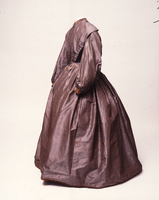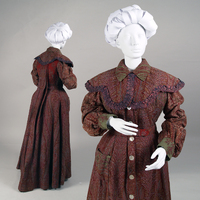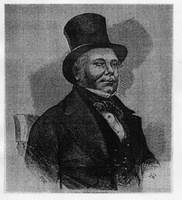Items
Creator is exactly
Unknown
-
 Layette Pincushion This layette pincushion is made of light-blue fabric, faded from the sun and mottled in places. A message pricked out in pins reading “God Bless Thee my baby” appears in cursive in the centre of the cushion. The first three words are capitalized and separated by pinheads. A curved frame of pinheads surrounds the message, and there are decorative details at the top, bottom, centre, and corners of the frame. The top decoration resembles a crown, and the bottom decoration either a teardrop or a leaf. The corners of the frame are marked with triangular shapes. To the left and right of the pinhead frame, there are curved floral designs of ribbon rosettes in pink, blue, yellow, and white, and leaves in soft green. White lace trims all four sides of the cushion, which measures five inches wide, three and three-quarters inches deep, and two inches high. The pincushion’s provenance is unknown, but it most likely formed part of a baby’s layette and seems to have been made by its mother, as suggested by the possessive “my” in the message.
Layette Pincushion This layette pincushion is made of light-blue fabric, faded from the sun and mottled in places. A message pricked out in pins reading “God Bless Thee my baby” appears in cursive in the centre of the cushion. The first three words are capitalized and separated by pinheads. A curved frame of pinheads surrounds the message, and there are decorative details at the top, bottom, centre, and corners of the frame. The top decoration resembles a crown, and the bottom decoration either a teardrop or a leaf. The corners of the frame are marked with triangular shapes. To the left and right of the pinhead frame, there are curved floral designs of ribbon rosettes in pink, blue, yellow, and white, and leaves in soft green. White lace trims all four sides of the cushion, which measures five inches wide, three and three-quarters inches deep, and two inches high. The pincushion’s provenance is unknown, but it most likely formed part of a baby’s layette and seems to have been made by its mother, as suggested by the possessive “my” in the message. -
 Charlotte Brontë’s Dress Charlotte Brontë wore this dress on her honeymoon to County Clare, Ireland. The dress consists of a bodice and a skirt, each made of lavender-coloured, striped, medium-weight silk. The bodice is adorned with tan-coloured silk velvet cuffs and collar, and edged with ten small triangles trimmed with silk fringe. The full-length skirt, attached to a waistband, is gathered across the centre back, while the skirt front is flat with small pleats at either side. A small bustle would have been worn underneath. Both the bodice and skirt are close fitting around the waist and fully lined with cream-coloured cotton. The bodice fastens down the centre front with fourteen metal hooks and eyes, and the skirt fastens with two large metal hooks and eyes on the right hand side. The photos showing the interior of the dress reveal alterations and some of the damage to the interior caused by stress on the fabric.
Charlotte Brontë’s Dress Charlotte Brontë wore this dress on her honeymoon to County Clare, Ireland. The dress consists of a bodice and a skirt, each made of lavender-coloured, striped, medium-weight silk. The bodice is adorned with tan-coloured silk velvet cuffs and collar, and edged with ten small triangles trimmed with silk fringe. The full-length skirt, attached to a waistband, is gathered across the centre back, while the skirt front is flat with small pleats at either side. A small bustle would have been worn underneath. Both the bodice and skirt are close fitting around the waist and fully lined with cream-coloured cotton. The bodice fastens down the centre front with fourteen metal hooks and eyes, and the skirt fastens with two large metal hooks and eyes on the right hand side. The photos showing the interior of the dress reveal alterations and some of the damage to the interior caused by stress on the fabric. -
 Dinah Craik’s Hidden Mother Portrait In this black-and-white photograph, Dinah Craik embraces her sixteen-month-old adopted daughter, Dorothy. Craik stands beside her daughter, her left hand winding around her waist, while she bends to obscure her own face entirely behind Dorothy’s head. The photograph, which is housed in a private collection, is a portrait of Dorothy, whose gaze is directed at the viewer. Wearing mary jane-style shoes and a white-frilled dress that complements a similar white frill on her mother’s collar, Dorothy sits patiently with her arms relaxed at her sides. All that is visible of Craik herself are her hand, body, and ear, as well as her muted, conventional clothing and a dark band around her hair. Written across the bottom of the white and gold cardboard frame in blue ink are the words “Mrs. Craik l’auteur de John Halifax, Gentleman / mai 1869.”
Dinah Craik’s Hidden Mother Portrait In this black-and-white photograph, Dinah Craik embraces her sixteen-month-old adopted daughter, Dorothy. Craik stands beside her daughter, her left hand winding around her waist, while she bends to obscure her own face entirely behind Dorothy’s head. The photograph, which is housed in a private collection, is a portrait of Dorothy, whose gaze is directed at the viewer. Wearing mary jane-style shoes and a white-frilled dress that complements a similar white frill on her mother’s collar, Dorothy sits patiently with her arms relaxed at her sides. All that is visible of Craik herself are her hand, body, and ear, as well as her muted, conventional clothing and a dark band around her hair. Written across the bottom of the white and gold cardboard frame in blue ink are the words “Mrs. Craik l’auteur de John Halifax, Gentleman / mai 1869.” -
 Tea Gown The maker and place of origin of this tea gown are unknown but it was created from a European shawl, likely circa 1891. The gown is pictured at two angles on a white mannequin with a white paper headpiece; the back and front are showcased. Intricate vegetal and paisley patterns on different colour fields adorn the wool fabric. The gown is visually striking with a straight collar closed at the neck, a detachable shoulder cape trimmed in purple silk, fashionable full sleeves with cuffs, a fabric belt, and, over the belt in back, a series of box pleats from neck to floor called “Watteau pleats.” The collar, right hip pocket, and cuffs are cut from shawl sections with an olive field, while the belt and back bodice are cut from sections with a brighter shade of red than the rest of the gown, which is predominantly burgundy. The gown closes at centre front with mother-of-pearl buttons. The pleated back structure provides volume at the skirt but, unlike the eighteen-century style for which Watteau pleats are named, pleats are stitched down at the upper bodice to help delineate a corseted figure.
Tea Gown The maker and place of origin of this tea gown are unknown but it was created from a European shawl, likely circa 1891. The gown is pictured at two angles on a white mannequin with a white paper headpiece; the back and front are showcased. Intricate vegetal and paisley patterns on different colour fields adorn the wool fabric. The gown is visually striking with a straight collar closed at the neck, a detachable shoulder cape trimmed in purple silk, fashionable full sleeves with cuffs, a fabric belt, and, over the belt in back, a series of box pleats from neck to floor called “Watteau pleats.” The collar, right hip pocket, and cuffs are cut from shawl sections with an olive field, while the belt and back bodice are cut from sections with a brighter shade of red than the rest of the gown, which is predominantly burgundy. The gown closes at centre front with mother-of-pearl buttons. The pleated back structure provides volume at the skirt but, unlike the eighteen-century style for which Watteau pleats are named, pleats are stitched down at the upper bodice to help delineate a corseted figure. -
 A Policeman's Hat This black-and-white engraving of Charles Frederick Field, a retired detective of the Metropolitan Police Force, attributed to an 1855 issue of the “Illustrated News of the World,” features Field wearing his policeman's hat. In the image, Field sits on a chair with his torso facing slightly towards the right; the portrait captures the upper part of his torso and we can see the top part of the chair sketched in behind him. He wears a black top hat tipped back on his head as well as a version of the same clothing he would have adopted as a plainclothes detective: jacket, vest, white shirt, and cravat. A shadow behind him frames his head and adds depth to the image. The shading indicates that the hat is dark in colour but does not provide any information about the hat’s material.
A Policeman's Hat This black-and-white engraving of Charles Frederick Field, a retired detective of the Metropolitan Police Force, attributed to an 1855 issue of the “Illustrated News of the World,” features Field wearing his policeman's hat. In the image, Field sits on a chair with his torso facing slightly towards the right; the portrait captures the upper part of his torso and we can see the top part of the chair sketched in behind him. He wears a black top hat tipped back on his head as well as a version of the same clothing he would have adopted as a plainclothes detective: jacket, vest, white shirt, and cravat. A shadow behind him frames his head and adds depth to the image. The shading indicates that the hat is dark in colour but does not provide any information about the hat’s material.